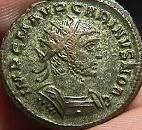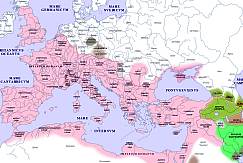Roman Emperors Dir Carinus
Carinus (283-285 A.D.)
William Leadbetter

Carinus was the elder of Carus' two sons. By the time of his father Carus' accession, in late 282, he was a grown man with a wife, Magnia Urbica, and, possibly, a son, Nigrinianus.[[1]] Soon after his father's accession to power, along with his brother Numerian, he was made Caesar with the titles nobilissimus Caesar and princeps iuventutis .[[2]] Carinus almost immediately shared the title of Germanicus Maximus, probably won by his father in his campaign against the Quadi and Sarmatians.[[3]]
Carinus was ordinary consul with his father in 283, and early in the year was raised to the rank of Augustus.[[4]] The collegiality between father and son, like that between Valerian and Gallienus, served both as a dynastic bulwark of the new régime, and also to ensure an imperial presence in two places simultaneously. Carus himself departed with Numerian to wage war in Persia while Carinus was left in Gaul to guard the provinces of the west.[[5]]
This was as well. Carus' death in distant Persia left Carinus as the elder Augustus, able to maintain a semblance of order and act as a focus for the loyalty of the soldiers. There is some evidence that he continued his father's Danubian war with a campaign against the Quadi.[[6]] He spent the winter of 283/4 in Rome where he also commenced his second consulship, with Numerian as colleague.[[7]] From there he proceeded to Britain where he conducted a campaign which received lyrical celebration by the contemporary poet Nemesianus, and for which both he and Numerian took the title Britannicus Maximus.[[8]]
Despite the dynastic continuity reflected in Carinus' succession, the death of Carus did present opportunities for the ambitious and discontented. The revolt of Sabinus Iulianus in Pannonia occurred soon after the news of the death of Numerian, in Novermber 284, arrived in the west.[[9]] It required a response from Carinus, busy in distant Britain. Early in 285, he marched south against Iulianus and defeated his forces near Verona. From there he proceeded to Moesia where his army met that of Diocletian in battle at the Margus River in July. According to hostile tradition, his army was victorious, but at the moment of triumph he was slain by a trusted officer whose wife he had seduced.[[10]] A variant tradition records that he was deserted by his army, an assertion made more plausible by the continuity in office of his Praetorian Prefect, the consul Aurelius Aristobulus, under Diocletian.[[11]]
The story of Carinus' murder by an officer is consistent with the negative tradition about him in the literary sources. This tradition, which would seem to derive from the Kaisergeschichte, depicts him as a bloodthirsty tyrant who executed senators, raped their wives and murdered those who had teased him at school.[[12]] The Historia Augusta fraudulently records that he had nine wives, and ignores his one genuine spouse, Magnia Urbica.[[13]] This negative view of Carinus was no doubt generated and encouraged by Diocletian, but has dominated most subsequent accounts and assessments.
BIBLIOGRAPHY
H.W. Bird, "Diocletian and the deaths of Carus, Carinus and Numerian", Latomus 35 (1976) pp. 123 - 132.
Eutropius: Breviarium. Translated with and introduction and commentary (Liverpool, 1993).
Chastagnol, André "Trois études sur la Vita Cari" Bonner Historia Augusta Colloquium 1972/4 (1976) pp. 75 - 90.
Richard N. Frye ,The History of Ancient Iran (Munich, 1984).
Jones, A.H.M., J.R. Martindale, and J. Morris. "Carinus," The Prosopography of the Later Roman Empire Vol. I (Cambridge, 1971) p. 181.
Kienast, Dietmar. Römische Kaisertabelle: Grundzüge römischen Kaiserchronologie (Darmstadt, 1990).
Leadbetter, Bill "Another Emperor Julian and the Accession of Diocletian" Ancient History Bulletin 8 (1994) pp. 54 - 59.
P. Meloni, Il Regno di Cari Numeriano e Carino (Cagliari, 1948).
M. Peachin, Roman Imperial Titulature and Chronology, A.D. 235 - 284, (Amsterdam 1990).
E.A. Pond Inscriptional Evidence for the Illyrian Emperors: Claudius Gothicus through Carinus, 268 - 284 AD (Diss. Mich. 1970).
Notes:
[[1]] PLRE I p, 631; Kienast (1991) p. 258. The coins and inscriptions of Nigrinianus give no clear idea of his paternity. It is also possible that he was the son of Carus' daughter Paulina.
[[2]] On Carinus' titulature see Peachin, (1991) pp. 451 - 471; Pond (1970), p. 241.
[[3]] Peachin (1991) p. 98 f.; Pond, (1970) p. 239.
[[4]] Aur. Vict ,de Caes. 38.2; Eutr., 9.19.1; Pond, (1970) p.239; Peachin suggests that Carinus was made Augustus in the spring of 283 ( 1991, p. 98 ); see also Meloni (1948), pp. 61 - 79.
[[5]] Aur. Vict. de Caes. 38.2; On Carinus' task in the west, Meloni (1948) pp. 79 - 87.
[[7]] CJ 8.54.5; Kienast (1991) p. 256 f.
[[8]] Nemesianus, Cynegetica, 64 - 73; Dessau, ILS 608; Kienast (1991) p. 257; Peachin (1990) p. 99.
[[9]] Aur. Vict. 39. 9 - 10; Leadbetter (1994), p. 56 f.
[[10]] Aur. Vict. 39. 11; Eutropius (9.20.2) records that he was deserted by his army. See H.W. Bird (1976) p. 131.
[[11]] Aurelius Victor (39.15) notes this is an example of Diocletian's unusual clementia. It might equally be evidence of Aristobulus' treason. Aristobulus not only retained the offices of consul and Praetorian Prefect, but went on to a proconsulship of Africa and the tenure of the Urban Prefecture (PLRE I p. 106).
[[12]] Eutr. 9. 19; Ep. de Caes. 38.6; Zonaras 12. 612. On the neagtive historical tradition about Carinus see Chastagnol (1976) pp. 84 - 90. See too the comments of H.W. Bird (1976) p.130; (1993) p.146.
[[13]] SHA Vit. Car. 16.6 - 7.
.
For more detailed geographical information, please use the DIR/ORBAntique and Medieval Atlas below. Click on the appropriate part of the map below to access large area maps.

